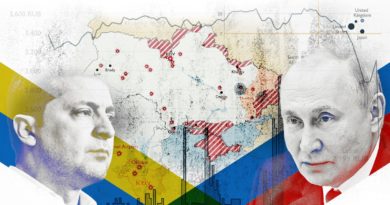Broken URLs helped fuel the unfounded conspiracy theory about biolabs in Ukraine

Ukraine’s biological research laboratories have been in the news in recent weeks as Russia, China and a number of media pundits falsely claimed that their existence was proof that the U.S. was partnering with Ukrainian scientists in a “secret” biological weapons program.
That’s not true, as PolitiFact reported. The labs do not involve biological weapons at all. They are part of a longstanding partnership with Ukraine to protect against disease outbreaks, not to create them. The program is an ongoing, multi-country effort, and while likely obscure to many until recently, it has never been a secret.
But some questioning the nature of the labs have become suspicious because they say the U.S. Embassy in Ukraine removed fact sheets about the labs on its webpage about the Biological Threat Reduction Program.
“Have we yet received any explanation for why the US embassy in Kiev removed the fact sheets pertaining to their biological labs in Ukraine from their website?” conservative commentator Candace Owens tweeted on March 10, sharing screen shots of four fact sheets. “Why did our department of defense fund them and what does ‘permit for working with pathogens’ mean?”
Fox News host Tucker Carlson and others made similar claims that the broken PDF links are a sign that the government is trying to hide something.
However, when you visit the embassy webpage today, a section on the right rail links to fact sheets about various labs. The fact sheets contain general information about the labs, including the type of assistance being provided by the U.S. and the cost.
We reached out to Owens, who told us that the current links go to different URLs than the ones that were there previously that she said were “deleted.”
So what’s going on?
The links to the fact sheets have been broken since May 2021, a State Department spokesperson told PolitiFact. That was the end result of a website upgrade that took place in 2015 and 2016.
All content was to be moved from the “photos.state.gov” server, but the PDFs of the fact sheets were not updated in the transition, the spokesperson said. The broken links had gone unnoticed until recently, when the labs became a talking point in the Russian war on Ukraine.
“Due to recent interest, the Embassy came to realize these links had been broken and restored them in the interest of transparency last week,” read a statement provided to PolitiFact by the State Department spokesperson.
A check of archived pages proves the State Department’s timeline, and also Owens’ assertion that the links weren’t working on the day she tweeted about them.
Archived pages show that the links to the fact sheets Owens referenced were broken as late as the morning of March 10, when Owens published her tweet. But they were replaced with working links on different URLs later that day.
For example, the original link to a fact sheet about the Dnipropetrovsk Diagnostic Laboratory in Ukraine went to a broken URL starting with “photos.state.gov,” according to an image of the website captured by the Internet Archive at 2:12:58 a.m. GMT on March 10. Later that day, that fact sheet linked to a new, functioning URL starting with “ua.usembassy.gov,” according to a new image of the website captured at 4:09:18 a.m. GMT.
The content of the fact sheet, meanwhile, remained unchanged.
We checked the Internet Archive, and it shows that the four fact sheets Owens’ tweeted were each crawled as late as May 2021, something Owens also pointed out.
We asked the State Department why those links would still be working then if the website was upgraded in 2016. That’s because the old server was left online after the upgrade, the State Department said after looking further into the matter.
In May 2021, however, the department took down photos.state.gov as part of a routine review of servers that was designed to conserve resources and enhance security. Any remaining links were broken at that point, a spokesperson told PolitiFact.
The fact that the links were broken when scrutiny on the labs surfaced recently may seem suspicious to some, but that is not evidence that the information was intentionally removed or being hidden. The fact sheet section was still displayed prominently on the right rail of the webpage with the names of laboratories. The original URLs were still there and easily viewable using the Internet Archive site.
If someone seeking this information couldn’t find it on the website, the material still would have been subject to federal Freedom of Information Act disclosure. But even a simple inquiry would have done it, a State Department spokesperson told us, because the agency intended them to be publicly available on the website, despite claims otherwise.
This article was originally published by PolitiFact, which is part of the Poynter Institute. It is republished here with permission. See the sources here and more of their fact checks here.


